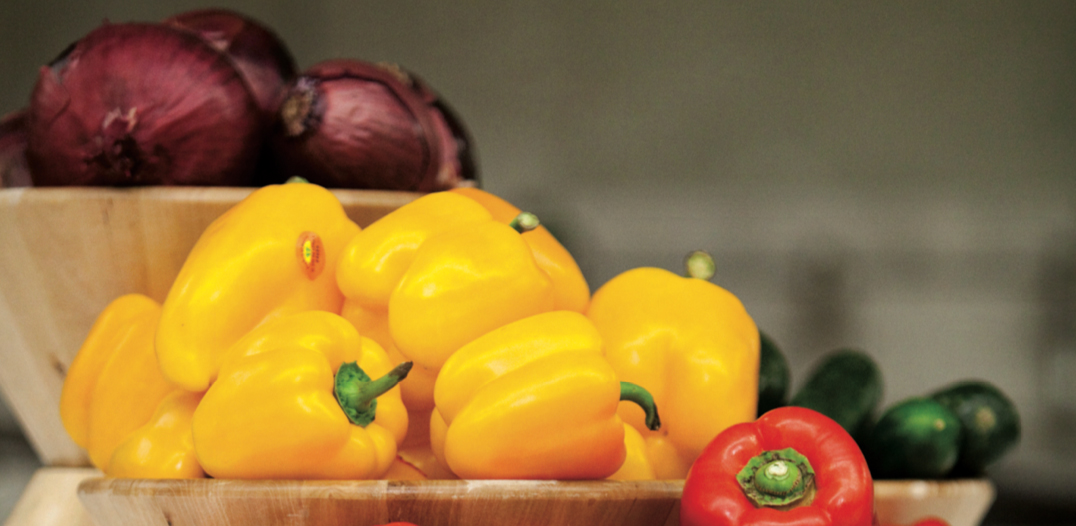
Remember the dining halls? You can still get a burger and fries, but pretty much everything else has changed.
By Molly Petrilla | Photography by Greg Benson
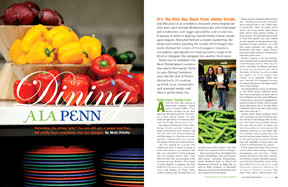
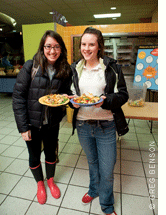
It’s the first day back from winter break, and this place is as crowded as its lunch menu (vegetarian chili and a well-stocked Mediterranean bar and fresh-made deli sandwiches and veggie quesadillas and on and on). A woman in white is making roasted-turkey Caesar salads upon request. Stationed behind a sizable countertop, she mixes and tosses, handing the results off to hungry students. Behind her, crates of fresh peppers, tomatoes, cucumbers, and squash are lined up neatly, ready to be diced or chopped, then plopped into another fresh meal.
Think you’ve stumbled into West Philadelphia’s trendiest new eatery? Not exactly. You’re in 1920 Dining Commons and, like the rest of Penn’s dining halls, it’s cooking up fresh, local, sustainable and seasonal meals—and they’re pretty tasty, too.
Going Green, Buying Local
About five years ago, a group of determined students visited Laurie Cousart’s office. “They literally knocked on my door and said, ‘We want local food,’” the director of Penn Dining recalls. “I’d never really thought about it in that way, and I said, ‘You’re right. Tell me what to do.’”
She began working with Penn’s then-dining services provider Aramark to bring in food from local sources, and this past fall Penn Dining teamed up with Bon Appétit—a food-services management company that now oversees all campus dining and retail facilities.
“We were looking for a partner who understood what it meant to bring in fresh, bold tastes to our students, and who was committed to local programs and our Climate Action Plan,” says Marie D. Witt C’81, vice president of the business-services division. They found it in Bon Appétit, a company that bills itself as Food services for a sustainable future and focuses on “fresh, from-scratch cooking and serving food in a socially responsible manner,” says Paul Bulau, the company’s district manager.
Since arriving at Penn, Bon Appétit has forged relationships with local farmers and dairies, including Pennsylvania-based Hendricks Farm in Telford and Beechwood Orchards in Biglerville, as well as Kilby Creamery in Maryland. About 20 percent of the dining halls’ food now comes from local sources.
Meals are also prepared without short cuts. “Nothing is processed, and nothing is coming from a can,” Bulau says. In particular, salad dressings, pasta sauces, and soups—foods many dining halls remove from cartons, bottles, or freezer packs—are all made from scratch at Penn. Bon Appétit has even created an herb garden in the greenhouse-like basement of 1920 Commons, so a chef who needs rosemary can simply run downstairs and snip a sprig. They’re planning to add tomatoes, strawberries, and other plants soon.
Student response to the new management company and its approach has been overwhelmingly positive. Witt says voluntary meal-plan enrollment has gone up nearly five percent this year, and in December, The Daily Pennsylvanian gave Bon Appétit one of its tough-to-earn “cheers” in its biannual “Cheers and Jeers” editorial, “for bringing its mission of using locally grown and organic products to Penn Dining.”
The dining-hall fare is now “much fresher,” says Kevin Tucker, a Wharton senior who’s had a meal plan his entire time at Penn. While he says the overall difference in taste isn’t as vast as he’d imagined, he’s enjoyed trying new dishes, such as a goat cheese and tomato tart (“I was like, ‘Wow, I definitely did not see this in the dining halls a few years ago’”).
College senior Roopa Gogineni hasn’t had a meal plan since her freshman year, but still eats in the dining halls on occasion. She’s been there a handful of times this year, and says that “it seems a lot better now; there are more options, the sandwich selection is a lot better, they have multiple soups instead of just one, and the food just seems fresher. It’s nice to visit and have [access to] a lot of fresh fruit and vegetables, because those can be hard to find elsewhere on campus.”
Foodie alums have also been excited to hear about Penn Dining’s change in management and priorities. “That’s exactly the kind of step that a university of Penn’s caliber should be taking,” says Lolis Eric Elie W’85, a food writer and author of Cornbread Nation 2 and Smokestack Lightning: Adventures in the Heart of Barbecue Country. “The move from these cookie-cutter conglomerates to an organization that is more concerned about the quality of food is consistent with what the Penn mission should be.”
Still, some members of the Penn community are more difficult to impress: “I think it’s okay,” says Nursing freshman Andres Sepulveda as he’s finishing off some French fries in 1920 Commons. “For cafeteria quality, this is pretty good.”
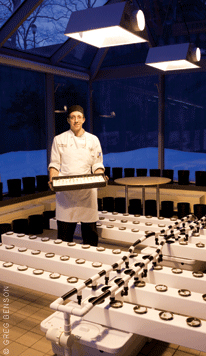
Dining at Penn: the Basics
The dining-hall experience has long been a staple of student life at Penn. As a freshman in the late 1970s, Jimmy Shaw W’83 lived in Hill House, one of the few dorms with an in-house dining hall. Shaw, now the owner and executive chef of the popular Loteria! restaurants in Los Angeles, still remembers walking out of his dorm room, wandering downstairs, and sitting down to a dining-hall meal with his friends and classmates. “It was a big part of my freshman year,” he adds, “even though the meals themselves were just large-scale institutional food.” Occasionally, he ventured to the 1920 Commons dining hall, though its location across campus was “far less convenient.”
These days, students with meal plans have their pick of campus eateries, each known among undergraduates for different qualities. There are in-residence halls in Hill (farthest) and Kings Court College House (quietest); 1920 Commons (good for breakfast), which is convenient to the Quad and the high-rise College Houses; and the all-Kosher dining facility Falk Commons. In case you’ve lost count, that’s four full-fledged dining halls, along with a to-go station in the Quad and nine retail facilities scattered throughout the campus.
Every freshman must purchase a $4,080 meal plan, with various combinations of dining-hall visits and dining dollars available (the latter are accepted by Penn-owned retail dining facilities). About half of sophomores choose to purchase a meal plan, with the percentage dropping to 20 for juniors and just 10 for seniors, many of whom live off campus. Students describe this as a self-perpetuating cycle: few upperclassmen have meal plans, so even fewer want to eat in the dining halls amid a sea of freshmen.
Other students say that cost is the greater deterrent. Upperclass meal plans offer various combinations of meals and dining dollars, and range from $1,392 per year (60 visits and 600 dining dollars) to $4,080 (650 visits and 100 dining dollars), with the average cost at around $3,000 per year. “Most students figure they can just take that $3,000 and buy other food or eat out at food trucks for the same price,” Tucker says. “[That approach] is much cheaper than paying for a meal plan.” (Witt says that the University’s meal plans are “value-priced” and rank competitively with Penn’s peer institutions, hovering near the low end cost-wise.)
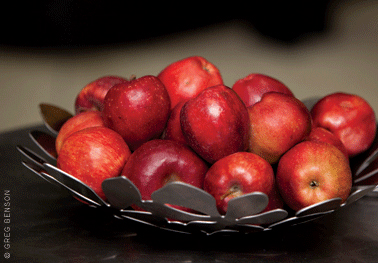
Kings Court Dining Hall, Lunchtime
It’s not even noon yet, and the swarm of hungry students has already descended on Kings Court’s dining hall, grabbing salads or soup or the day’s special, broccoli-chicken-pasta bake. Several students have said this is the best Penn dining hall food-wise, and based on the selection of sophisticated dips alone (chipotle hummus, basil white bean, black bean southwest hummus), it’s easy to believe them.
But as both students and Penn Dining officials will tell you, the dining-hall experience is about more than just food. Since freshmen are required to have meal plans, they spend a lot of time in the dining halls, and grabbing a meal together is “always this implicit excuse for freshmen to see their friends and meet new ones,” says Tucker, who is also a Resident Advisor. In fact, looking back from her senior year, Roopa Gogineni says she met some of her closest friends over dining-hall meals, when “we’d linger over our food for hours.”
And that’s exactly what the Penn Dining higher-ups are aiming for: “The dining program is critical to creating community in the residences,” says Witt, who’s currently seated toward the back of the Kings Court dining hall. “In this College House in particular, you’ll see a lot of faculty eating with the students.” Sure enough, amid the tables of hungry students are a few professor-types engaging in conversation with and eating the same food as the students.
With their crowded tables and warm comfort foods, for many the dining halls are about as close to Mom’s kitchen as college gets. And since Penn has the largest number of international students in the Ivy League—hailing from more than 100 different countries—the food selection tends to be diverse. On a given day in the dining halls, you might start with a Western frittata, return for a lunch of Vietnamese curry soup with a side of couscous salad and eggplant dip, then grab dinner from the Korean noodle bar or a cheeseburger or Cuban sandwich.
The vegetarian options are equally plentiful. Dishes like sundried tomato quiche with garlic-roasted eggplant, falafel with sautéed broccoli rabe, and tofu green-bean curry have made dining-hall vegetarianism at Penn so effortless that PETA named the University to its 2009 list of the 10 “most vegetarian-friendly colleges.”
Compare these varied ethnic and vegetarian choices to the selection Shaw remembers from the late 1970s: “salad or sandwiches or soup or ‘blackened something,’” he says. “There was usually a sandwich of the day, a burger of the day, and at dinner, a fish protein or a chicken protein. At Commons, they had a salad bar and soft-serve ice cream, which were about as adventurous as it got.”
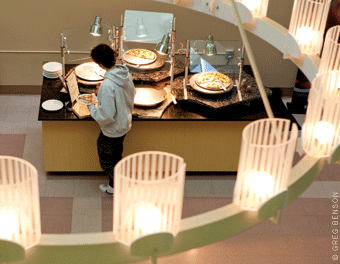
Houston Hall Market, Lunchtime
Wharton freshman Christianna Hay is finishing her lunch in Houston Market, Houston Hall’s underground eatery. “It’s fine,” she says, a container of vegetarian sushi in front of her. “I was warned by my upperclassmen friends that the food [on campus] would be horrendous, but it’s actually been pretty good.”
Around her, other students are eating Indian curries or carne asadatacos or grilled veggie burgers—just a few of the expanded offerings Bon Appétit has brought to Houston Market, carved out of the venerable student union’s basement as part of the Perelman Quadrangle renovation/construction project completed in 2000. It’s one of the more popular Penn-owned “retail markets,” all of which accept dining dollars via Penn Card, as well as old-fashioned cash or credit cards. Other retail options include a Starbucks and Subway at the 1920 Commons Market, cafés in the library and engineering buildings, a grab-and-go station in the Quad, and an Einstein Brothers Bagels adjacent to Houston Market. While the dining halls feed mostly students and faculty members, these retail eateries often serve staff and community members as well.
“I think they have one of the best carry-out burgers here,” says James J. Riley, administrative and financial officer for the Department of Cancer Biology and the Abramson Family Cancer Research Institute. He’s been grabbing the occasional lunch in Houston Market for over a decade, and is currently enjoying a bacon cheeseburger and fries there. (Burgers are also the bread-and-butter—or more accurately, specially made brioche and grass-fed local beef—of the Burger Stop in the 1920 Commons Market.)
Still, keeping up with ever-changing student palates can be like recreating a favorite restaurant’s spicy chili at home: nearly impossible to pin down just the right combination. To that end, “we’re always watching to see what students are eating or what they’re buying, and changing out what doesn’t work,” Cousart says. Earlier this semester, that meant transforming the Hershey’s Ice Cream bar in the 1920 Commons Market into Yo-Reka!—a self-serve Greek yogurt bar with a plethora of fruit, nut, and granola toppings. Bulau says that Yo-Reka! grew out of a student focus group, and has already been “wildly successful.”

The adjacent UnCommon Market is also in the midst of transition, from a Wawa-wannabe to a Whole Foods-inspired minimart. It now stocks energy bars, trail mix, fresh fruit and other staples of a healthy diet, and last fall, sold pints of pumpkin, ginger-snap, and molasses ice cream. The source of that creamy fall delight? The Penn Veterinary School’s dairy in Kennett Square, Pennsylvania, which works with a nearby creamery to produce ice cream.
Dining officials hope to begin offering the remaining skim milk—left over when the fat is skimmed off for ice cream—in campus dining halls soon, and to obtain local, humanely raised pork from the Vet School’s soon-to-be swinery. After all, for Penn diners, it doesn’t get much fresher than Quaker-raised cows and pigs.
Molly Petrilla C’06 is jealous of the changes in Penn Dining since she graduated. A Philadelphia-based freelancer, she writes the Gazette’s arts-and-culture blog.




